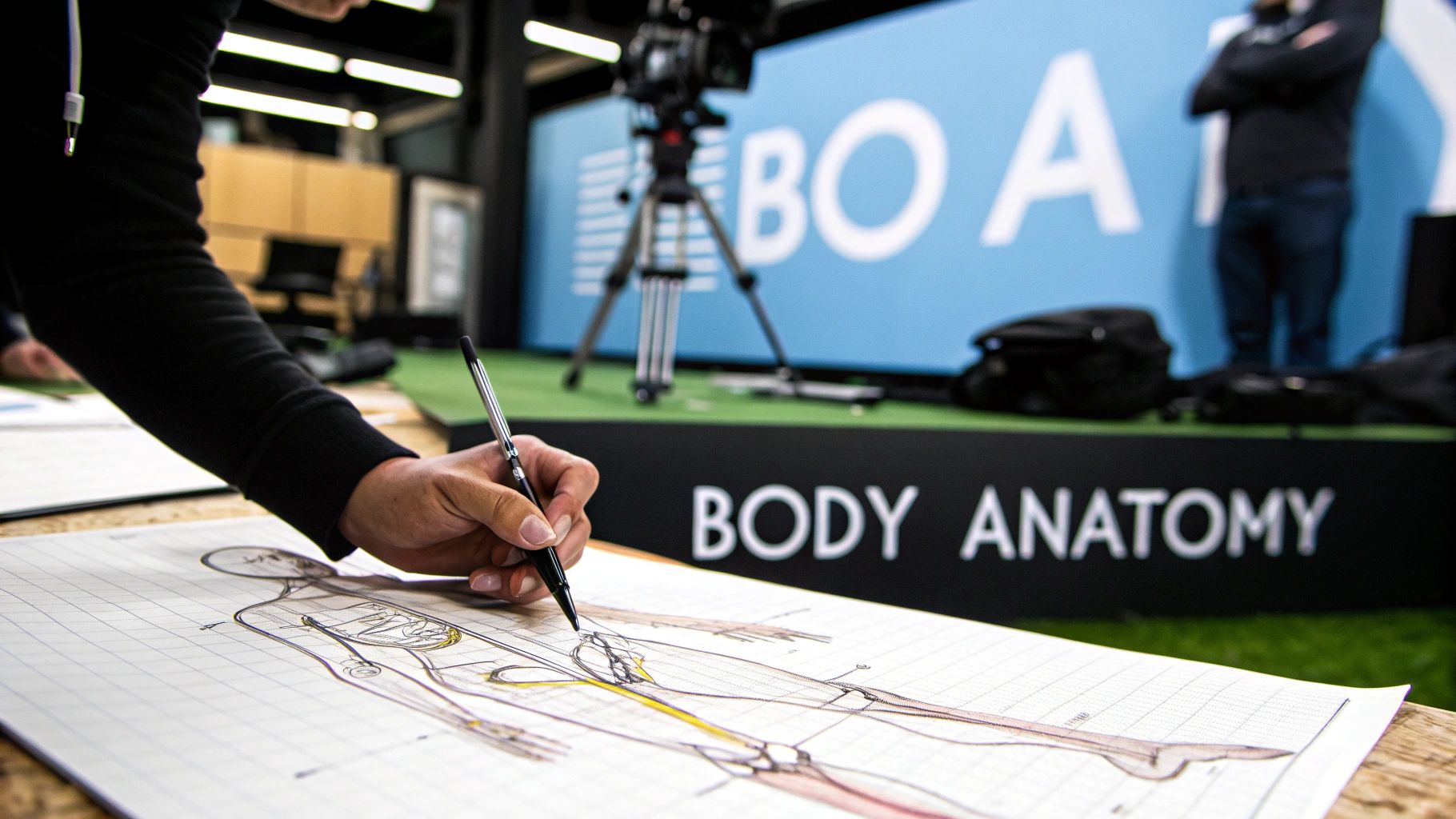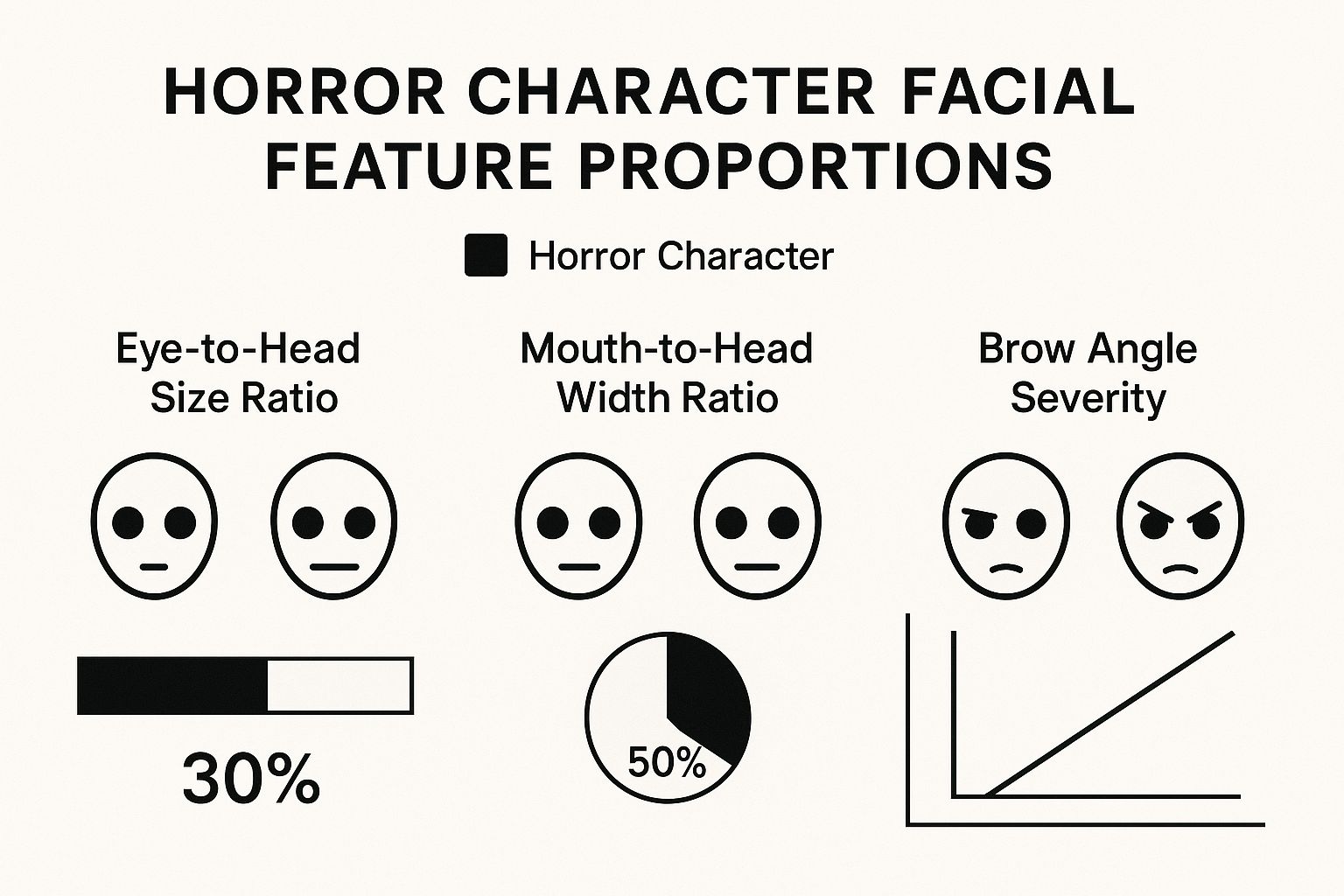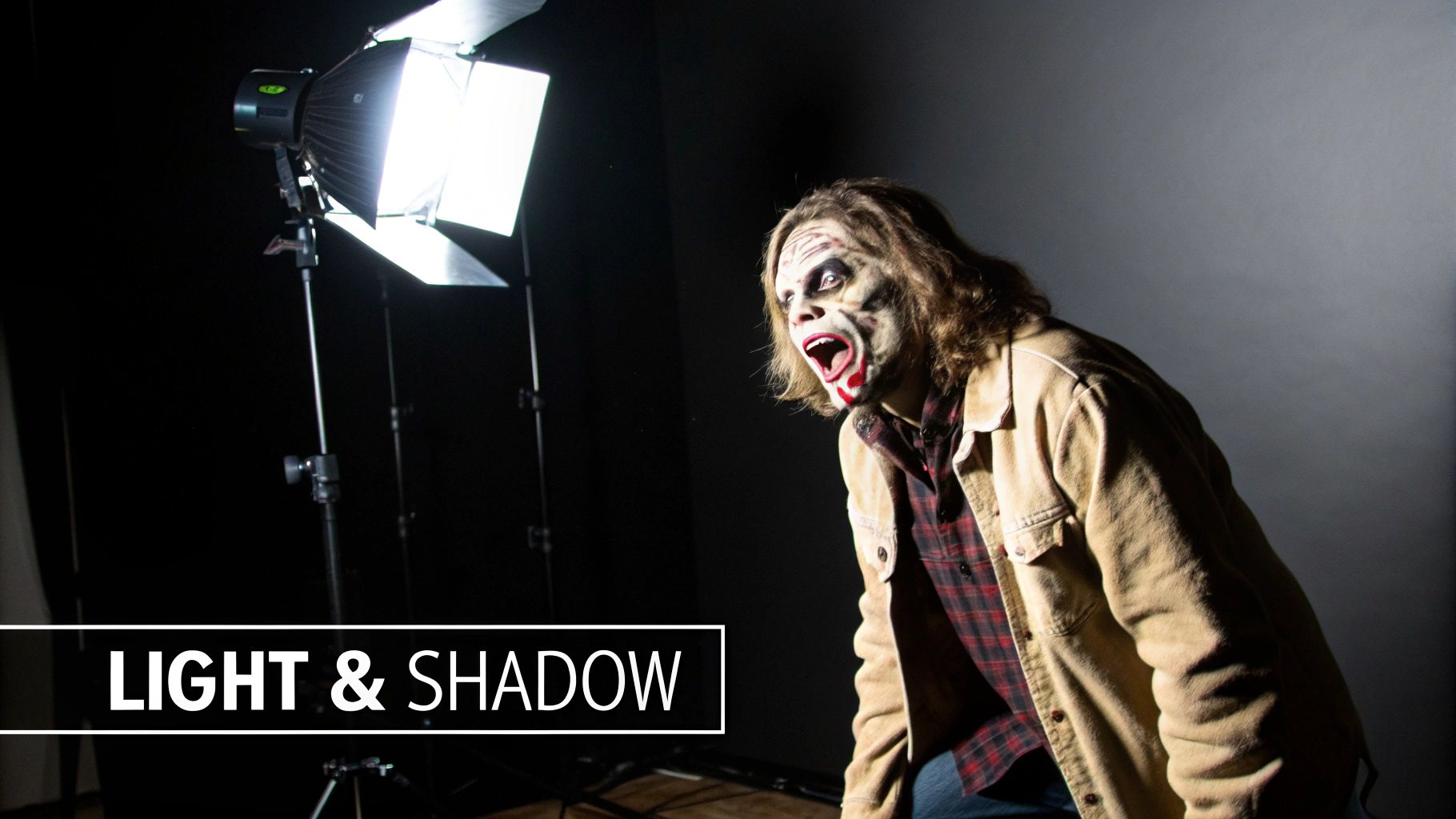Drawing a truly terrifying character isn't just about anatomy and technique. It's a deep dive into psychology, a dance with artistic skill, and a real understanding of what makes people's skin crawl. You’re not just putting lines on a page; you’re crafting something that taps into primal fear, disgust, or that quiet, creeping sense of dread.
This is where your journey from a blank canvas to a genuinely chilling creation begins.
The Foundations of Fear in Character Art

Before you even touch pencil to paper, you have to get what makes a monster monstrous. Real horror art isn’t built on buckets of blood and cheap jump scares. It’s rooted in psychology, in our shared cultural history of what we imagine is lurking just out of sight. It’s about poking at the things that make us feel small, vulnerable, and profoundly unsafe.
Think of it this way: a well-designed creature tells a story. Every scar, every unnaturally twisted limb, every dark and hollow eye socket whispers something about its nature, its origins, and what it’s capable of.
Where Our Nightmares Come From: Gothic Lit and Classic Cinema
The monsters we fear today? They're standing on the shoulders of giants. I'm talking about the icons from gothic literature and old-school horror films. Characters like Dracula, Frankenstein's creation, and the Wolf Man weren't just simple villains. They were complicated, exploring heavy themes like loneliness, the dangers of forbidden knowledge, and the darkness inside all of us. They built the blueprint.
Film, especially, has programmed our visual language of fear. The way movie monsters have evolved is a direct reflection of audience tastes and, believe it or not, censorship. Take Dracula's Daughter from 1936. Universal Studios got a lot of heat from European markets, which pushed horror design away from explicit gore and toward something more suggestive.
That shift taught artists a crucial lesson: what you don't show is often more terrifying than what you do. It’s all about building suspense, and that’s a golden rule for your own character art.
Key Takeaway: The most iconic horror characters connect to universal fears. They aren't just monsters; they're symbols of our anxieties about death, the unknown, and losing control.
To get you started, here's a quick breakdown of the core pillars you'll need to think about.
Core Elements of Horror Character Design
| Core Element | What It Means for Your Art | Quick Tip |
|---|---|---|
| Psychological Triggers | Tapping into common phobias (spiders, clowns, the dark) or existential dread. | Twist something familiar. A smile that's too wide, a shadow that moves on its own. |
| Visual Storytelling | Using details like scars, posture, or clothing to hint at the character's backstory. | Don't just draw a monster; draw a monster that survived something. Or caused it. |
| Atmosphere & Mood | Using light, shadow, and composition to create a sense of unease or danger. | Obscure parts of your character in shadow. The viewer's imagination will fill in the blanks. |
| Archetypal Roots | Building upon classic horror templates (ghosts, slashers, cosmic horrors). | Know the rules of the subgenre so you can bend or break them effectively. |
These elements are your foundation for creating something that doesn’t just look scary, but feels it on a deeper level.
Finding Your Unique Style Within Horror Archetypes
Horror is a massive playground with tons of different sandboxes, each with its own vibe and visual rules. Getting a feel for these archetypes is the first step to finding your own creative voice.
- Supernatural Specters: Ghosts, demons, phantoms. These things often break the laws of physics. Their horror comes from their otherworldliness and the pure psychological terror they inflict.
- Brutal Slashers: Think Michael Myers or Jason Voorhees. These are grounded, human-shaped forces of nature. The fear here is their relentless, unstoppable physicality. Their designs are often deceptively simple but instantly iconic.
- Cosmic Beings: This is your H.P. Lovecraft territory. These creatures are so alien and mind-bending that just looking at them is a threat to your sanity. We’re talking tentacles, impossible angles, and way too many eyes.
When you start to understand these concepts, you graduate from just sketching "something scary" to designing characters that have real purpose and impact. This foundation is so important because it ties directly into many of the basic design principles that give all art its power.
Choosing Your Creative Tools for Terror

Every artist has their go-to tools, but when you're drawing horror, your choices get a lot more specific. The right tools aren't just for making marks on a page; they're for creating visceral effects that claw their way out of nightmares and into reality. Your toolkit is what translates a terrifying idea into something someone can actually see.
For those of us working with traditional media, graphite pencils are the foundation. A classic mistake I see is artists sticking with a single HB pencil for everything. You just can't get those deep, velvety shadows essential for horror that way. You need softer leads like a 6B or 8B. They're perfect for filling in those dark, hollow eye sockets or rendering a heavy, ominous cloak.
On the flip side, harder leads like a 2H are your best friend for sketching faint, ghostly outlines or adding subtle, eerie textures to a creature's skin.
This isn't just about picking up a random pencil. Deliberately choosing your tools is a huge part of the process. It's how you apply the core https://creativize.net/blog/principles-of-visual-design that make an artwork truly hit home.
Embracing Messy and Precise Mediums
I like to think of charcoal as the punk rock of drawing tools. It’s messy, it's raw, and it's absolutely perfect for horror. Vine charcoal is fantastic for creating broad, atmospheric shading—think soft, hazy backgrounds that build a sense of creeping dread. Compressed charcoal sticks, however, deliver those intense, brutal blacks for more aggressive textures, like charred flesh or the deep, dark corners of a monster’s lair.
But for those crisp, unsettling details? Nothing beats a good set of fine-liners. Use them to render the intricate cracks in a porcelain doll’s face or the sharp, clean lines of a surgical instrument. That contrast between the chaotic mess of charcoal and the clean precision of ink can be incredibly powerful.
Pro Tip: Don't be afraid to mix things up. I love using a wash of diluted India ink over a charcoal drawing. It creates this aged, grimy look that feels ancient and deeply unsettling. Experimentation is how you'll find your own signature horror style.
If you're working digitally, the world of brushes can feel overwhelming, but you really only need a few key types to handle 90% of your work.
- Textured Brushes: Find ones that mimic charcoal, splatters, or grit. These are non-negotiable for creating organic decay and environmental grime.
- Soft Airbrushes: These are perfect for rendering ghostly apparitions, ethereal glows, or the subtle gradients on slick, alien skin.
- Hard Round Brushes: This is your workhorse. It’s what you’ll use for clean lines, sharp teeth, and defining any hard-surface elements on your creature.
And don't forget, your digital toolkit can go way beyond 2D. If you're looking to branch out, there's some great 3D modeling software for beginners that can completely open up new ways to design your monsters.
Twisting Anatomy For Unsettling Designs
Let's be real—true horror in character design rarely comes from just slapping on some horns or fangs. The most unsettling monsters come from twisting what we expect to see. You see a human shape, but something is just… wrong. This is where you get that deep, psychological unease.
That's the power of warping anatomy. You're taking the familiar and making it monstrous. This is why knowing the rules of anatomy isn't just for drawing realistic people; it’s so you know exactly which rules to break for the biggest impact.
Instead of just adding gore, think about the structure underneath. What if the ribs were visible, but bent outwards like a grotesque external cage? What if a creature's arms had one too many joints, letting them scuttle and bend in unnatural, spider-like ways? These are the kinds of subtle shifts that are far more disturbing.
Elongate Proportions Purposefully
One of the oldest tricks in the book—and one of the most effective—is playing with proportions. Stretching out limbs creates a sense of wrongness that's instantly recognizable. Just think of creatures like the Slender Man or the nightmarish figures from a Guillermo del Toro film. Their impossibly long fingers or stretched-out legs give them an eerie, inhuman grace that’s both elegant and utterly terrifying.
Here’s a quick exercise I love to do:
- Start with a simple sketch of a human skeleton.
- Now, double the length of the forearms and the shins.
- But here's the key: keep the hands and feet the same size. That contrast makes the elongation pop, making it feel even more grotesque.
This kind of deliberate exaggeration messes with our primal understanding of the human form. It signals that this creature isn't bound by our physical laws, which immediately creates a predator-prey dynamic. Its reach is longer and far more threatening than our own.
The secret to effective horror anatomy isn't just distortion, but believable distortion. The viewer should be able to look at your creature and think, "That's wrong… but I can almost see how it could work." This grounds your horror in a twisted, uncomfortable reality.
Getting the most out of your monstrous forms means having a solid workflow. For a deeper look at organizing your creative projects, check out our guide on the design process steps. It's great for structuring your character creation from the first spark of an idea to the final, polished piece.
The Power Of Posture And Pose
Anatomy isn't just about the skeleton; it's about how that skeleton is held. Posture tells a story all on its own.
A character hunched over, with a contorted spine and shoulders pulled up high, can scream agony, feral rage, or a creature desperately trying to hide its true size. On the flip side, a figure standing unnaturally straight with limbs locked at rigid angles can feel robotic, soulless, and completely unnerving.
Horror art has always been tied to cinema's most iconic monsters. Think about it—franchises like Friday the 13th (12 films) and A Nightmare on Elm Street (9 films) have inspired a mind-boggling amount of fan art online, well over 1 million pieces. This proves that horror character design is a massive niche. In fact, some estimates suggest it makes up around 11% of all commissioned character art globally.
Anatomy can be twisted in countless ways to bring different monsters to life. Here's a quick comparison of how you might alter standard features for a few classic horror archetypes.
Anatomical Twists for Horror Characters
| Anatomical Feature | Standard Depiction | Horror Variation (e.g., Zombie) | Horror Variation (e.g., Eldritch Being) |
|---|---|---|---|
| Spine | Gentle S-curve, flexible | Rigid or broken, shambling gait | Unnaturally fluid, serpentine movement |
| Limbs | Proportional to torso | Often broken or dislocated | Elongated, extra joints, tentacled |
| Hands | Five fingers, capable grip | Gnarled, stiff, missing digits | Too many fingers, impossibly long, claws |
| Jaw | Hinged, normal range of motion | Dislocated, hanging slack, broken | Unhinging, mandible-like, toothy maw |
As you can see, the same basic feature can be distorted in wildly different ways to tell a unique story of horror, whether it's the mindless decay of a zombie or the reality-bending form of something from beyond.
This next image breaks down how even small changes to facial proportions can create a distinctly unsettling effect.

The key takeaway here is that enlarging the eyes and mouth while sharpening the brow are powerful tools for pushing a design from human to monstrous. It's all about making those calculated, creepy adjustments.
Crafting the Face of Absolute Fear
Once you've twisted the body into a terrifying shape, you get to the good part: the face. This is where the real horror lives. It’s how your audience connects—or disconnects—with a character, and it’s your best shot at creating that deep, lasting sense of dread.
So, how do you draw a face that’s genuinely nightmarish? It starts by ditching the obvious.
Forget simple angry or sad expressions. True horror is much more subtle. Think about the feelings that really get under our skin: the hollow, dead-eyed stare of someone who isn't all there, the stretched, silent scream of a ghost, or that unnervingly pleasant smile on a monster that knows it has you trapped. These are the emotions that stick with people long after they look away.
Triggering the Uncanny Valley
Ever see something that looks almost human, but a few details are just… off? That creepy-crawly feeling is the uncanny valley, and for a horror artist, it’s pure gold. You can tap into this feeling with small, deliberate distortions in the facial features.
Try some of these unsettling tweaks I’ve used in my own work:
- Eyes Just a Little Too Wide: This is a classic for a reason. It can suggest mania, shock, or a total break from reality. Don't just make them big—make sure you show a bit too much of the white around the iris. That’s the ticket.
- A Smile That Feels Empty: A character grinning from ear to ear while their eyes stay cold and lifeless is a one-way trip to the uncanny valley. The mouth says one thing, but the eyes are telling the real, horrifying story.
- A Chilling Lack of Emotion: Sometimes, the most terrifying thing a character can do is nothing at all. A completely placid, neutral expression during a moment of absolute chaos is deeply unsettling. It suggests a creature that just doesn't operate on a human level.
The goal isn’t to make the face look monstrous in a cartoonish way. You want to make it look wrong on a deep, psychological level. It’s the small, almost imperceptible flaws that create the biggest unease.
These little details are everything. It’s the same principle in any visual medium—the small choices are what shape how an audience feels. If you're into that sort of thing, digging into a good animation style guide can really open your eyes to how visual language works.
Embedding History with Scars and Decay
A face isn’t just a set of features; it's a map of a character's entire history. Every line, scar, and bit of decay tells a story without you ever having to write a word. This is how you add layers of lore and dread to your design.
For example, a deep, jagged scar across an eye doesn't just look cool. It screams of a violent past, a brutal struggle for survival. Wrinkles aren't just about age; you can draw them to show a lifetime of torment, etching lines of permanent fear or cruelty into the skin.
Think about what decay can say. Is the skin peeling away to show something mechanical underneath? Is it rotting in a way that feels more like a supernatural curse than natural decomposition? Details like these transform your drawing from a simple monster into a character with a dreadful, untold history, leaving your audience to imagine the horrors it has both endured and inflicted.
Using Light and Shadow to Build Dread

Here's a secret every horror artist knows: what you don't see is almost always scarier than what you do. Light and shadow are your best friends for getting under an audience's skin, turning a simple drawing into something that genuinely gives people the creeps.
In horror, shadows aren't just empty space. They're an active, breathing presence on the page.
Think of yourself as a director staging a scene. You decide what the spotlight hits and—more importantly—what it swallows whole. This little game of peek-a-boo builds incredible suspense and forces the viewer's imagination to do the heavy lifting, filling in the blanks with their own worst fears.
The Power of Chiaroscuro and Negative Space
The classic technique of chiaroscuro, with its heavy-handed contrast between light and dark, is an absolute staple in any horror artist's toolkit. It’s not just about making your characters look 3D; it’s about carving them out of an oppressive, inky blackness.
Try using a single, harsh light source. A flickering candle, the cold, narrow beam of a flashlight, or the sterile glow from a TV screen can all cast long, distorted shadows that twist and warp your character’s form into something barely recognizable.
This is how you create a heavy, claustrophobic atmosphere. For instance, imagine lighting only the top half of a monster's face, leaving its mouth and body completely lost to the darkness. Is it smiling? Is its body something too hideous to comprehend? The viewer has no idea, and that uncertainty is the dread.
Key Insight: Start treating negative space like it's a character itself. The empty, dark voids around your subject can hint at a threatening presence just out of frame, making the whole scene feel watched.
Rendering Visceral Textures
Okay, so light and shadow set the mood. But texture? Texture is how you get a physical, gut-level reaction. You want your audience to feel the image, not just look at it. This is all about rendering, and it’s where you can really tell a story.
A few textural choices can make all the difference:
- Slick and Wet: Use sharp, bright highlights to create the glistening sheen of fresh gore or the slimy coat on some alien beast. It immediately makes you think of things that are cold, damp, and unnatural.
- Rough and Decayed: Go wild with cross-hatching and stippling to build up the brittle texture of old, rotting bandages, desiccated flesh, or splintered wood. This screams age, neglect, and decay.
- Otherworldly Smoothness: Sometimes, the most unsettling texture is no texture at all. A perfectly smooth, porcelain-like surface on a creature can feel deeply, profoundly alien and wrong.
Mastering these techniques isn't just for personal projects; it's a crucial skill for anyone wanting to break into the industry. The market for horror character design is massive, and research into horror games shows that over 70% of titles released since 2010 feature original characters inspired by classic film monsters. If you want to dive deeper, you can discover more about the influence of horror archetypes in modern media and see how these foundational skills apply.
So, How Do You Find Your Own Horror Style?
You’ve got the basics down, the building blocks are in place. Now for the fun part: finding your unique voice in the crowded chorus of screams. This is where you graduate from just drawing horror characters to creating art that’s unmistakably yours. It's one thing to learn the rules, but it's another thing entirely to break them with intention.
First, go on a deep dive. Get lost in horror's countless sub-genres. The gory, in-your-face visuals of body horror speak a totally different language than the slow, creeping dread of a psychological thriller. Pay attention to how different artists tackle the same monsters. A vampire drawn by Mike Mignola feels like it comes from a different universe than one by Bernie Wrightson, right? That's style.
It's All About Experimentation
Honestly, the only way to find your style is to get your hands dirty and experiment. You have to be willing to try things that feel weird or even a little uncomfortable at first. That's where the real breakthroughs happen.
Here are a few exercises I've found incredibly useful for shaking things up:
- The Line Weight Challenge: Draw the same character three times. For the first pass, use a single, thin line weight. On the second, go super thick and heavy. For the third, mix it up, using varied weights to pull the viewer's eye where you want it to go.
- The 3-Color Terror: Force yourself to create a genuinely scary scene using only three colors. This makes you lean hard on mood and composition instead of just throwing a full palette at the problem.
And when you inevitably hit a wall—we all do—don't be afraid to look for inspiration in weird places. I’ve found some of the best strategies to unlock your creativity in guides meant for writers. A good idea is a good idea, no matter the discipline.
Your style is a cocktail of your influences, your experiments, and your own personal fears. It’s how you, and only you, translate terror onto the page.
So, lean into what genuinely creeps you out. That authenticity is what connects with people. It’s what makes your creatures stick in their minds long after they've looked away.
Got questions about bringing your nightmares to life on the page? You're not alone. Every artist, myself included, has hit a wall wondering if their creature design is just a cheap knockoff or how much gore is really necessary.
Let's dive into some of those common hurdles and get you back to creating.
First up, that nagging feeling of unoriginality. You spend hours sketching, only to step back and see a monster that looks suspiciously like something from a movie you just watched. It happens. Seriously, don't sweat it.
My two cents: True originality isn't about pulling a completely new idea out of thin air—that's basically impossible. It's about how you mix and match your influences. Your personal spin on classic horror archetypes is what makes a design feel fresh and new.
How Much Gore Is Too Much?
This one's all about tone, not following some rigid rulebook. You have to ask yourself: am I going for a gut-punch of visceral shock, or a slow, creeping dread that gets under the skin?
Body horror, for instance, pretty much demands some explicit detail to land its punch. On the other hand, a ghost story can be way scarier with almost no gore at all. The real question is: does this gruesome detail serve the story you're trying to tell with your character? If it enhances the fear, great. If it’s just there for shock value and feels distracting, dial it back.
Busting Through Creative Blocks
Ah, the dreaded creative block. It’s the worst. Staring at a blank page when your brain feels just as empty is beyond frustrating.
My go-to move? Stop forcing it. Step away from the sketchbook entirely. Go watch a bizarre foreign horror flick, get lost in a book about ancient mythology, or just take a walk through an old, overgrown cemetery for some real-world inspiration.
Another trick I love is "automatic drawing." Just let your pencil wander across the page with no plan. Doodle aimlessly. You'd be surprised what kinds of subconscious shapes and ideas start to emerge. It’s a great way to get out of your own head. Sometimes, getting fresh eyes on your work can also shake things loose—much like how exploring effective small business marketing strategies for growth can spark new directions for a company, feedback can do the same for your art.
At Creativize, we’re all about connecting talented artists like you with businesses hungry for your unique vision. Ready to build your portfolio and land your next great project? Check us out at https://creativize.net.

